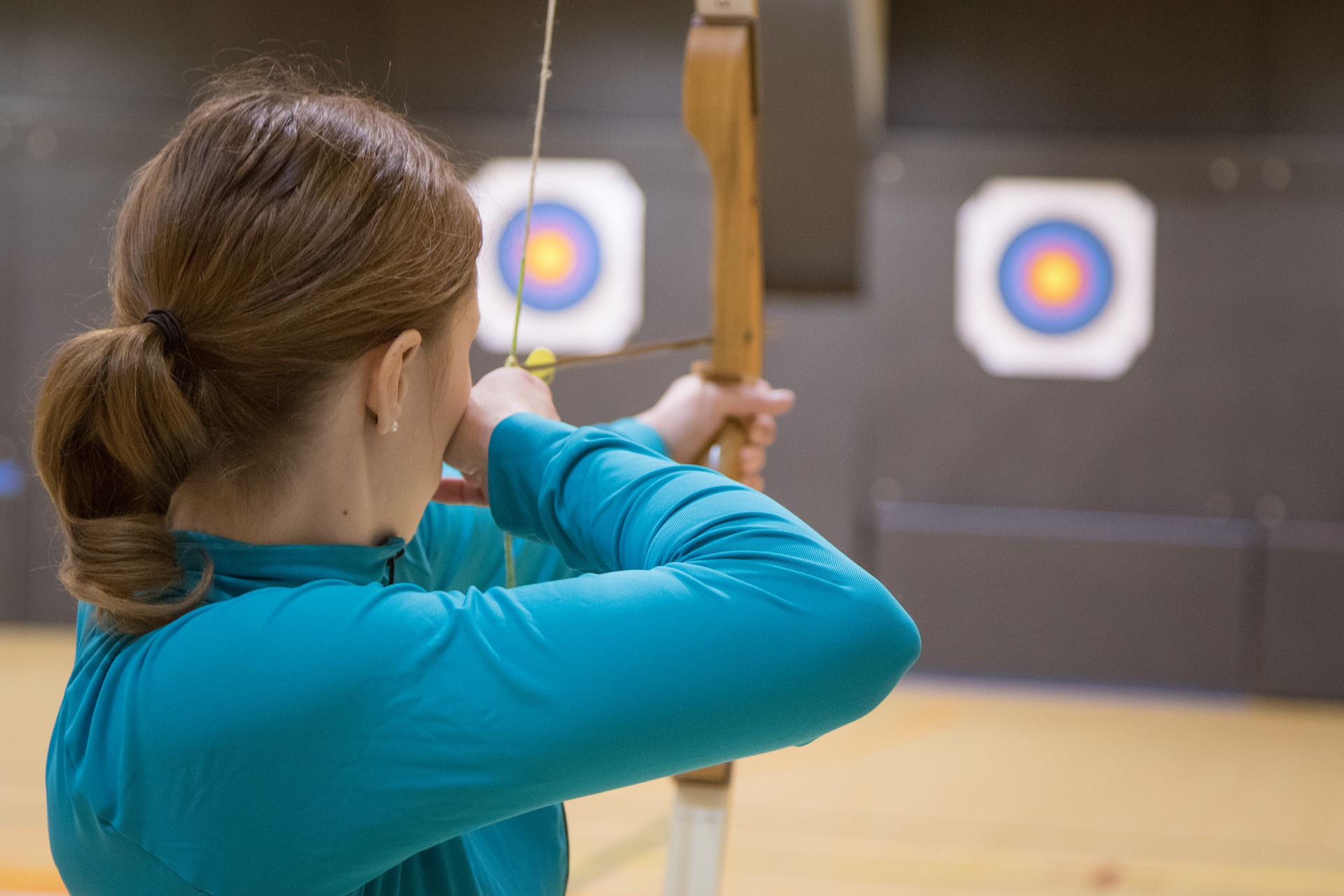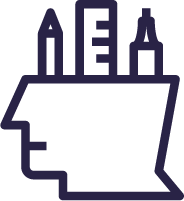Unit 2: Course Learning Outcomes and Assessments

Stay on target
As we mentioned in Unit 1, developing learning outcomes and corresponding objectives is the first step in backward course design. Identifying these goals helps ensure intentional course design during the planning phase.
In this unit, you will learn how to develop effective HyFlex course outcomes and objectives that align with the overarching program outcomes. You will also learn how to develop assessments that align with these learning outcomes/objectives.
Determine the end goals

Let’s start at the basics of course design by defining learning outcomes and learning objectives.
Learning outcomes are statements that describe to students the explicit knowledge, practical skills, and professional attitudes that they will acquire by the end of the course and/or program (Suskie, 2018).
Alternatively, objectives describe discrete units of knowledge and skill that can often be accomplished in a short period of time. The objectives work together to ensure students meet the learning outcome.
 Take Note
Take Note
In some instances, the word ‘objective’ may be used instead of ‘outcome’ as there is no universally recognized distinction between these two terms in academia.
For our purposes here, an outcome is used to describe a high-level learning goal, while objectives are used to refer to the specific knowledge, skills, and attitudes that students will learn and practice in order to meet the outcome.
Create quality learning outcomes
As a first step, careful consideration should be made when writing learning outcomes. After all, these outcomes provide the “road map” for your entire course; your students know “destination”, and you determine “how to get them there”.
Learning outcomes should include:
- A starting stem such as, “By the end of this [course], you will be able to…”
- Student-centred language; avoid jargon and discipline-specific terminology
- An action verb that indicates the depth of learning expected
- A statement of the learning that’s to be demonstrated (the what)
- A statement of the context or criteria in which learning will occur (the why or the how)
High-quality learning outcomes are also SMART:
- Specific (What do you want students to know/be able to do?)
- Measurable (How will you know students have achieved the outcome?)
- Attainable (Is it in your students’ power to accomplish this outcome in the time given?)
- Relevant (Is this outcome aligned to the program outcomes/vocational standards/workplace?)
- Time-bound (Can students realistically achieve this outcome by the end of the course/semester/program?)
 Example
Example
Using the structure outlined above, here is how a course outcome for an Introduction to massage Skills course was created:
| Sentence Stem | Action Verb | Learning Statement | Context/Criteria |
| By the end of this course, you will be able to | demonstrate | palpation techniques | to assess the health and tone of a client’s muscle tissue. |
Learning Outcome:
By the end of this course, you will be able to demonstrate palpation techniques to assess the health and tone of a client’s muscle tissue.
You can use Cambrian College’s Teaching and Learning Innovation Hub’s Creating Outcomes and Objectives Worksheet [docx] to help you draft program, course or lesson outcomes.
 Activity
Activity
Create corresponding objectives
Establishing objectives means determining what key skills, knowledge, and/or attitudes a student needs to achieve in order to meet the expectations of the learning outcome. Similar to outcomes, the objectives should start with a verb and include a learning statement.
Let’s return to our massage therapy learning outcome from earlier: By the end of this course, you will be able to demonstrate palpation techniques to assess the health and tone of a client’s muscle tissue. If you want students to demonstrate this skill, what would they need to know or be able to do first?
They may need to:
- Identify four palpation techniques commonly used in massage therapy
- Describe the palpatory differences between healthy resting tone, hypertonicity, spasticity or atrophy
- Practice palpation techniques on a peer to receive feedback on technique
- Record palpatory findings accurately in the patient file
These competencies now become the learning objectives for the palpation outcome.
Consider all modalities for HyFlex learning outcomes
The tricky thing about creating learning outcomes for HyFlex courses is that you must ensure they are all achievable for each mode of delivery. Some outcomes are more easily attainable for face-to-face students than for synchronous and asynchronous students.
Because of this, you need to ask yourself the following questions:
Are the outcomes specific, measurable, achievable, relevant, and time-bound for…
-
- face-to-face students?
- online synchronous students?
- online asynchronous students?
Is the action verb used attainable for…
-
- face-to-face students?
- online synchronous students?
- online asynchronous students?
Let’s revisit our Massage Therapy outcome and objectives to see if they are attainable for all modalities:
 Activity
Activity
Analyze the following learning outcomes and determine if it is a quality outcome or not.
Create quality assessments
Once learning outcomes and objectives have been determined for your HyFlex course, the next step is to develop assessments.
For many, it may seem counterintuitive to develop assessments before creating/curating content; however, in keeping with backward design, knowing the “destination” (i.e how students will demonstrate their learning) and aligning it with learning outcomes and objectives is a good way to ensure quality course design. It also helps determine the content and lessons required for success.
To start, keep these rules in mind: all assessments in a course must evaluate at least one learning outcome, and by the end of the course, all outcomes should have been assessed at least once. In many cases, multiple outcomes are assessed in one evaluation, like on a final exam.
First, make a plan
One way to ensure you have alignment between the outcomes and all of your course assessments is to create an Assessment Plan.
This Assessment Plan template [docx] by the Teaching and Learning Innovation Hub at Cambrian College provides guidance for aligning assessments to the outcomes of the course.
In the template, instructors identify:
- The type of assessments
- The purpose of the assessment
- The weight of the assessment (% of final grade)
- Activities that support the success of the assessment (ungraded practice activities)
- Alignment to specific outcomes and objectives
 Example
Example
Here is an example of a completed assessment plan [PDF] for the course Communication Skills for Justice Students.
Next, work out the details
After you complete the Assessment Plan, you can now determine the assessment details. What will students do? What steps should they follow? How will they be graded? How does this assessment reflect course learning?
To do this, you can use the Assessment Description template created by the Teaching and Learning Innovation Hub at Cambrian College. This template uses an evidence-based framework for creating assessment descriptions with all the necessary information for students to complete the task successfully.
This template includes the following sections:
- Purpose of the assessment (why students are doing this assessment + benefits)
- Value (percentage of final grade)
- Alignment to course learning outcomes
- Task (a short 1-2 sentence statement of what the students are expected to complete)
- Detailed step-by-step instructions (to provide students with a roadmap of what we are expecting)
- Clear grading criteria
- Additional details like how to submit the assignment and where to find additional resources needed to complete the assignment
Ideally, HyFlex assessment descriptions would be the same for students accessing the course in any mode; however, if there are variations to be considered in different modalities, provide adequate information about what is expected and from whom (students in which delivery mode).
To help save time, create assessments with format options for submission (text, audio, video, graphic, etc.) whenever possible. The grading criteria will remain the same for all submissions because the focus is on the learning outcomes/objectives rather than the product itself. This allows choice for students, provides flexibility regardless of mode, and saves time on grading.
 Activity
Activity
For one of your current courses, take a look at your assessments and consider if and how they would work in a HyFlex classroom. To do this, reflect on the following questions:
- Would you need to change the task? If so, how would you do that?
- Would you need to clarify anything in the assessment description considering students in any mode of delivery will complete this assignment? If so, what needs to be clarified and why?
- Would you need to change the grading criteria? If so, what needs to be changed and why?
- Would you need to change the way students are asked to submit their assignments?
- Would you need to change how students are asked to demonstrate their work (text, video, audio, their choice)?
Unit Summary
In this unit, you learned about the importance of creating quality outcomes and objectives to ensure students know what is expected of them during and by the end of the course. You also viewed outcomes and objectives via a HyFlex lens, ensuring that they are suitable for all modalities.
Then, you explored the next step in Backward Design: assessments. You considered how learning outcomes/objectives should align (and guide) all course assessments and how the different modalities must be considered.

